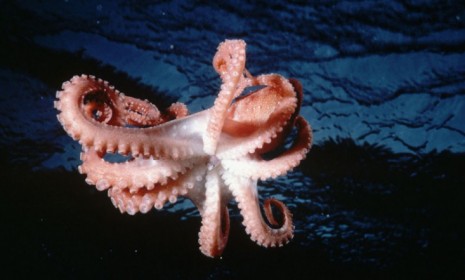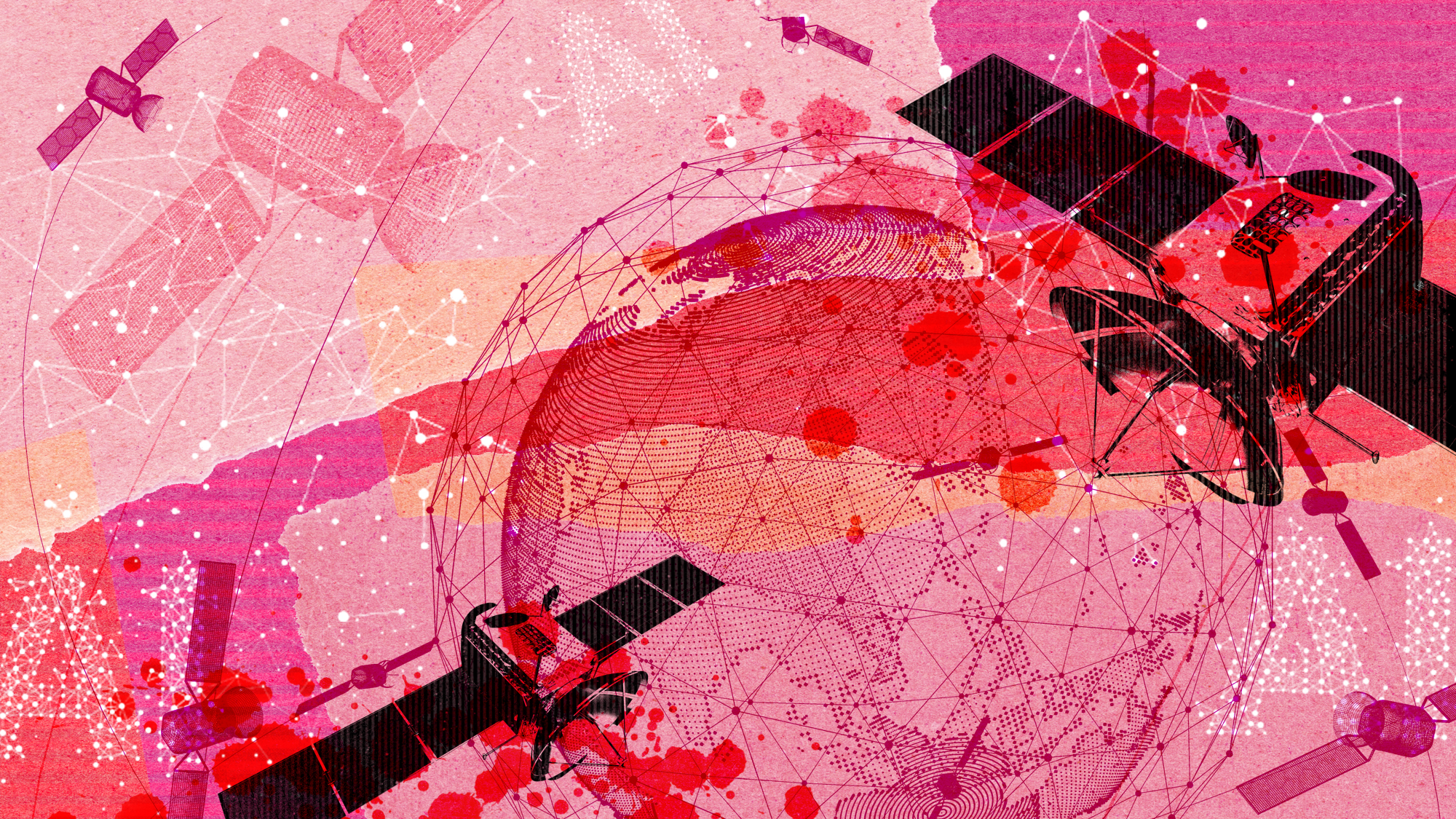What we can learn from the octopus
The wisdom of these eight-legged cephalopods, says Rafe Sagarin, can help us fight terrorism, natural disasters, and disease

FISH DON'T TRY to turn sharks into vegetarians. Living immersed in a world of constant risk forces the fish to develop multiple ways to live with risk, rather than try to eliminate it. The fish can dash away from the shark in a burst of speed, live in places sharks can't reach, use deceptive coloration to hide from the shark, form schools with other fish to confuse the shark — it can even form an alliance with the shark. All of these things may help the fish solve the problem of how to avoid getting eaten by the shark. But none of these adaptations will help the fish solve the general problem of predation, and it doesn't need to. The fish doesn't have to be a perfect predator-avoidance machine. Like every single one of the countless organisms it shares a planet with, the fish just has to be good enough to survive and reproduce itself.
Like the environment of fish and sharks, the world we spend our daily lives in is also full of risk: acts of terrorism, wars, natural disasters fueled by global changes in climate, a distribution of food that leaves billions undernourished and millions of others facing an obesity epidemic. The cyberinfrastructure that we increasingly rely upon has also become increasingly vulnerable to catastrophic attack. New diseases and new mutations of old diseases threaten to become global pandemics.
The major threats society faces today are ominous and complex interplays of human behavior and environmental change, global politics and local acts of cruelty or carelessness, historical accidents and long-simmering tensions. Some of these threats have plagued us as long as we have been human, and yet we've still made little progress against them; others are becoming more dangerous in synergy with rapid climatic and political changes; and still others are just now emerging. Yet the responses we have been offered or forced to accept by the experts we've trusted to solve these problems often seem frustratingly ineffective, naïve, or just plain ridiculous.
The Week
Escape your echo chamber. Get the facts behind the news, plus analysis from multiple perspectives.

Sign up for The Week's Free Newsletters
From our morning news briefing to a weekly Good News Newsletter, get the best of The Week delivered directly to your inbox.
From our morning news briefing to a weekly Good News Newsletter, get the best of The Week delivered directly to your inbox.
When increased body screening of airline passengers was implemented after 9/11, Richard Reid attempted to destroy an airliner with a bomb in his shoe; and when shoes began to be screened in response to Reid's attack, al Qaida plotted to use a liquid explosive attack; and when liquids were banned, Umar Farouk Abdulmutallab used a powdered incendiary hidden in his underwear in an attempted attack. Far from any airport, on a tiny island in the tiny town of Beaufort, N.C., there is a tiny outpost of the National Oceanic and Atmospheric Administration (NOAA). Although I lack high-level security clearances, I'm fairly certain this little laboratory — which studies fish and coastal ecology — is not on any terrorist group's list of targets. Yet when the NOAA coastal scientists wanted to renovate and add some space a few years back, they were forced by the Department of Homeland Security to install enormous Walmart-style parking lot lights on their facility as a required security measure. This was ironic, since the scientists working at the lab know full well that nighttime light pollution is a major threat to the same coastal marine environments that they are paid by taxpayers to study.
Life on Earth has a lot to show us about how to create more adaptable systems than these, but with the doors to this vast pool of expertise on adaptability blown open, a daunting new question emerges: Where to begin? In nature there are wings and eyes and claws and stingers and killer viruses and helpful bacteria, 13-year-long naps and 5,000-foot deep sea dives, suits of armor and solar energy factories, stolen poisons, and secret coded messages all working in some way to aid the adaptability and security of their owners. So, where would be a good place to start discovering which of these things would be useful to help solve our own security problems? If you want to learn about security and adaptability from nature, I can think of no better place to start than to stare into the eye of an octopus.
OCTOPUSES LEARN NOT only how to survive but how to thrive in almost any environment. Even in the barren, isolated tanks of a marine biology lab, colleagues have discovered octopuses escaping from their chambers and braving the dry air to scamper across a lab bench and find a snack in a nearby tank before returning to their own. But this portrayal reveals only part of the octopus's success. With its soft meaty body, the octopus is an attractive target for predators. So it constructs a protective den in the rocks, sometimes with a peephole for its keen eyes to peer out from. If good rocky crevices aren't available, it will learn to use whatever is around it — a shell, an old crate, or the champagne bottle tossed decades ago from my adviser's shipboard wedding just offshore from the Hopkins Marine Laboratory in Pacific Grove, Calif.
AN AMUSING VIDEO making the rounds on the Internet shows octopuses in Indonesia that have learned to forage the increased numbers of coconut shells discarded from tourist boats and pull together two halves to make a spherical suit of armor. When the octopus does venture out from its constructed bunker, millions of cells on the surface of its skin are all sensing and responding to the world around, instantly changing shape and color to perfectly match its immediate surroundings. Once, after staring at a tide pool in Baja California for a long time, I thought I spied an octopus, but the small waves cresting the tide pool walls riffled the surface too much to be sure. My eyes failing me, I reached my hand in to engage my tactile senses, and instantly a dark cloud of smoky ink filled the pool. By the time it cleared, I had confirmed my identification, but the beast was long gone.
A free daily email with the biggest news stories of the day – and the best features from TheWeek.com
John Steinbeck's good friend the marine biologist Edward F. Ricketts (who is fictionally portrayed as the character Doc in Cannery Row and other Steinbeck novels), in his guide to marine animals of the Pacific Coast, said this of the octopus's capacity to blend in and hide: "A little observation will convince one that in a given area probably half of the specimens escape notice despite the most careful searching — a highly desirable situation from the points of view of the conservationist…and the octopus." He added, "The octopus has an ink sac, opening near the anus, from which it can discharge a dense, sepia-colored fluid, creating a 'smoke screen' that should be the envy of the Navy."
And if those defenses don't work, the octopus has a powerful jaw and a mean bite, as the ever-curious Ricketts related in his field notes from a collecting trip in Canada: "Another big octopus. I've often wondered if octopi ever bite. Today I found out. Yes, they do, they certainly do."
The blue-ringed octopus takes this biting to extremes. When threatened, it flashes dozens of brilliant blue rings across its body, a warning to predators that it is armed — in this case with highly toxic bacteria, powerful enough to kill a human, that live symbiotically in the octopus's salivary glands.
But blending into the background, disappearing in a flash, and biting (usually) are not ways to find a mate, and mating is as essential to survival as avoiding predators. For that, an opposite tack is needed — one that sets an individual apart from all others. Some octopuses, when spying a potential reproductive partner, will split their missions — the half of their body facing the mate will pulse with a psychedelic display of color, but the half facing the rest of the world (including other competing male octopuses) is dull and inconspicuous, as if to say, "nothing special going on here."
Taken together, the octopus reveals almost all of the characteristics you would want in a biologically inspired adaptable security system. Its use of tools (the coconut shells) and its well-known ability to wreak havoc on laboratory containment systems show that it can learn from a changing environment. The rapidly changing skin cells show it has an adaptable organization in which a lot of power to detect and directly respond to changes in the environment is given to multiple agents that don't have to do a lot of reporting and order-taking from a central brain. That it has an ink cloud and camouflage and a powerful bite that it uses both for offense and defense reveals its redundant and multi-functioning security measures. Its ability to deliberately stalk, surprise, and even kill prey much larger than itself shows that it can manipulate uncertainty for its own ends. Finally, its use of deadly bacteria in its own defense reveals that it uses symbiotic relationships to extend its own adaptive capabilities. Not all organisms in nature display these characteristics so prominently as the octopus, but all organisms use them to varying extents to survive and adapt.
DESPITE THE MASSIVE variation in nature's security systems, all of their solutions follow from one very straightforward concept: adaptability. Adaptation arises from leaving (or being forced from) one's comfort zone. Accordingly, it's understandable that we might be a little resistant to dive into this strange world where reacting to the previous crisis is no longer good enough and making vague predictions of the future no longer counts as "doing something." It's natural that we'd come up with all sorts of excuses for why we can't be more adaptable. But one of the results of using nature — with its relentless ability to solve problems and neutralize unpredictable threats — as a template for adaptability is that it weakens almost every excuse we have for not becoming more adaptable.
The overwhelming success of adaptation in nature practically shames us into at least trying. And everything that seems like a barrier to change has already been crossed in nature. We complain that our bureaucracies are too institutionalized to change, but even organisms whose outer appearance has remained steadfastly unchanged for millions of years can be highly adaptable by farming out that adaptable capacity to semi-independent parts, like immune cells and skin color pigment cells. We argue that there are people we just can't work with or who will never come to peace with one another, but in nature the meekest organisms form beneficial symbiotic relationships with the most terrifying. We argue that we can't have guns and butter, but every successful living thing already knows how to balance a way to defend itself, a way to nourish itself, and a way to reproduce itself.
Perhaps the last remaining excuse is that we are just different altogether from every other living thing. At a mechanical, biochemical level, this can't be true. Under our hoods is the same DNA engine that powers most life forms. We may have neat flame decals and a clever dashboard GPS system, but we're essentially the same type of vehicle weaving through traffic (and occasionally driving right over it) on the road of life.
Adapted from Learning From the Octopus. ©2012 by Rafe Sagarin, reprinted by permission of Basic Books.
-
 A peek inside Europe’s luxury new sleeper bus
A peek inside Europe’s luxury new sleeper busThe Week Recommends Overnight service with stops across Switzerland and the Netherlands promises a comfortable no-fly adventure
-
 Space data centers could be joining the orbit
Space data centers could be joining the orbitUnder the radar The AI revolution is going cosmic
-
 Codeword: December 23, 2025
Codeword: December 23, 2025The daily codeword puzzle from The Week